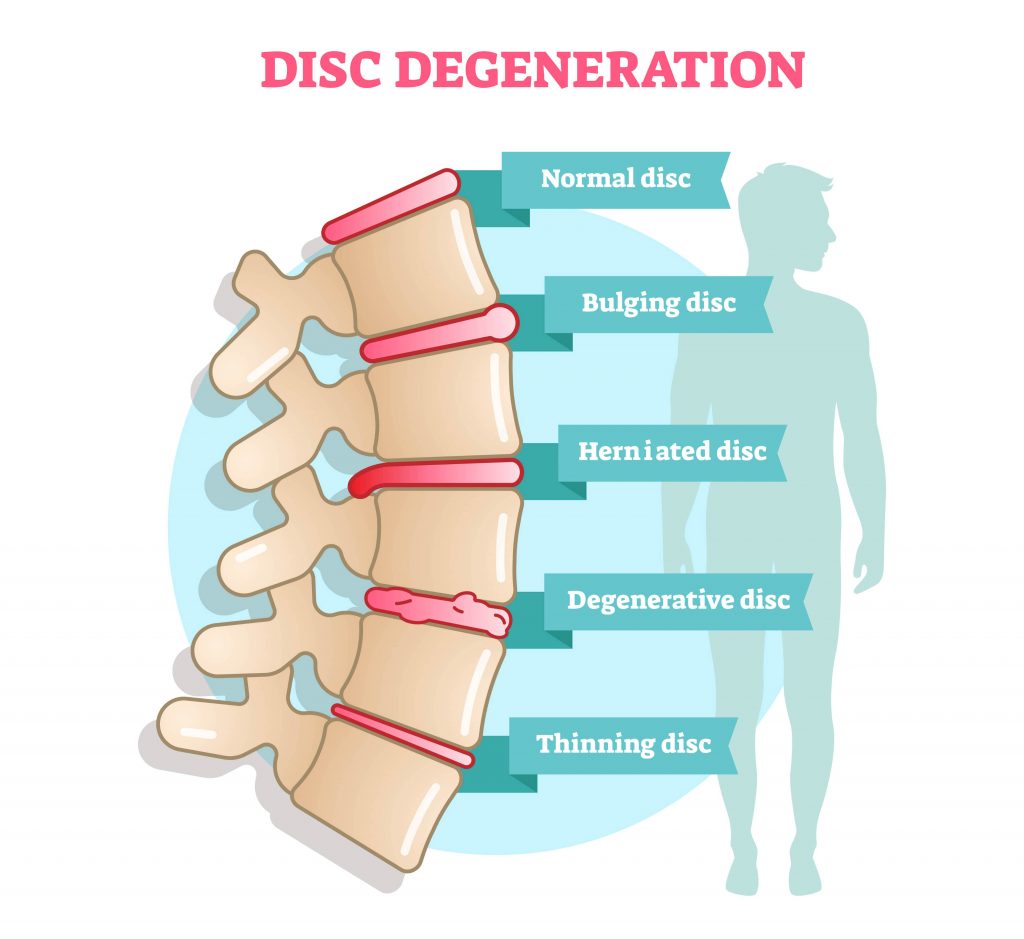
Quick Links
Degenerative Disc Disease
Herniated Discs
Thinning Discs
Bulging Discs
Non-Surgical Treatment
Our Knoxville chiropractic clinic provides treatment and pain relief for patients suffering from herniated discs, thinning discs, bulging discs, and degenerative disc disease.
The spine is made up of a series of bones that are stacked on top of each other and are separated by intervertebral discs. These discs are made of a soft mobile center encapsulated by layers of thick fibrous tissue. They are very strong structures that are fused to the tops and bottoms of each vertebrae.
These discs are imperative to allowing movement to take place in the spine. Without them, we would not be able to perform many of the simple rotational and bending movements that are vital to human locomotion. They also are very important for the absorption of forces transmitted throughout the body during all movements, even things as basic as sitting and standing.
The only time that our discs decompress and pressure is taken off of the discs is when we take our body out of gravity, such as when we lie down. When we are no longer vertical and gravity is no longer pressing down on our spine, the discs are able to decompress. This is a vital period as the decompression on the disc material allows for fluid to flow back into this area (instead of being pressed out while holding up the weight of your body) and they will “rehydrate”. This exchange of fluid allows for nutrients to enter into this area and for healing to occur.
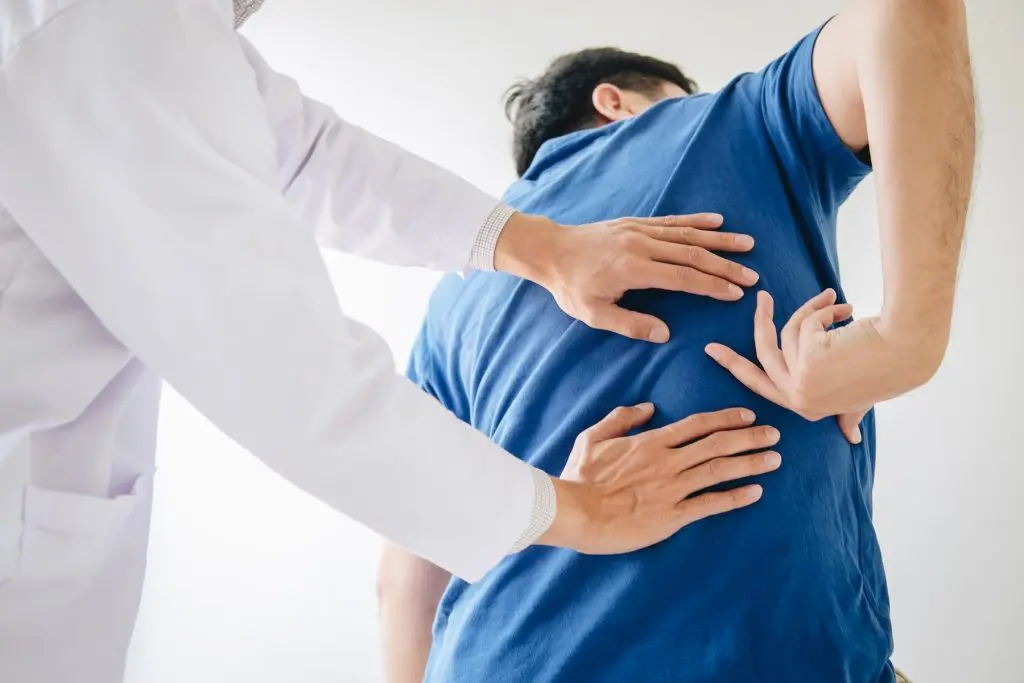
Jobs and activities that require a lot of bending, lifting, and twisting are also very hard on the spine and can lead to early-onset degeneration of the disc. These activities introduce a lot of “shearing” force to the disc and the spine. Over time, this will cause localized inflammation to the attachments of the disc to the vertebrae as well as tearing of the outer fibrous rings of the disc. When this happens, it leads to an increased likelihood of disc bulge or herniation as well as arthritic changes to the vertebrae themselves.
As a disc degenerates, another thing that happens is that the disc height will decrease. This can cause the facet joints (joints of the spine that join each vertebra together) to jam into one another, creating local irritation and inflammation. You may notice that looking up, bending backward, or twisting is more painful than other movements.
So, what is your move?
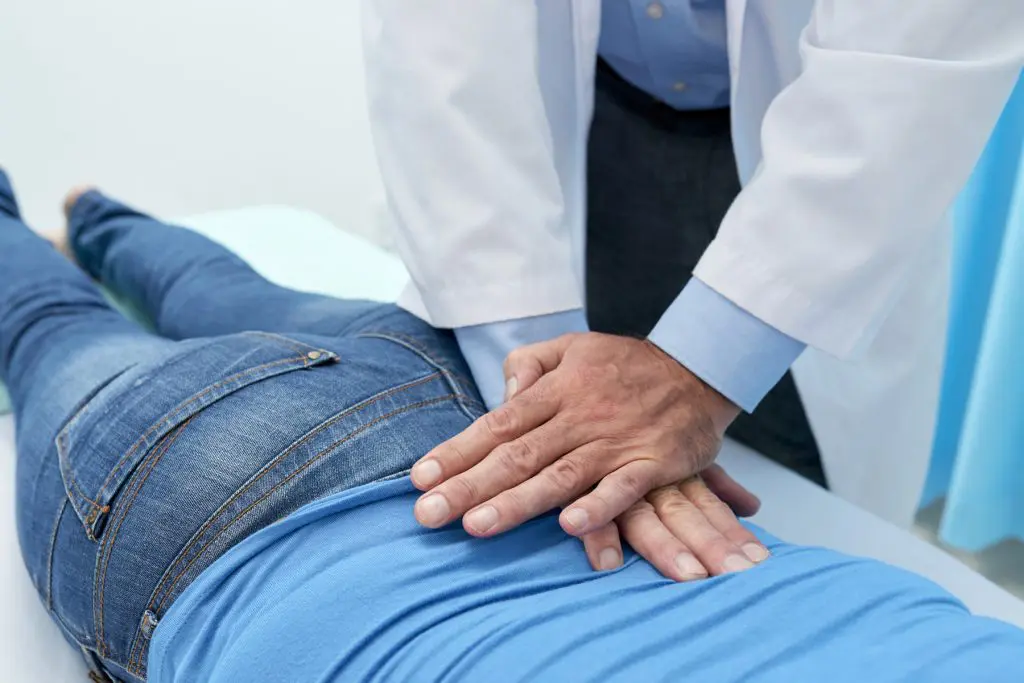
The end goal is to take a dysfunctional, painful area and make it move to its highest capacity so as to stop or slow the progression of degeneration in the spine. If done properly, the function can be greatly restored and you will get back to the activities you love.
If you have any questions please contact our degenerative disc disease doctor about whether your specific insurance will cover your visit, or what your benefits may be, call us at (865) 229-8796. We’d be happy to discuss any questions you may have.
Herniated Disc is the overarching term referring to multiple types of degenerative change to the intervertebral disc, specifically when the disc is beginning to protrude towards or into the spinal canal.
The anatomy here is fairly important when understanding the significance of herniated Discs. It is easiest to think of the vertebrae broken up into the front structures and the back structures. The back, or posterior, portion of the vertebrae houses the spinal cord and forms the canal in which the spinal cord lives. This spinal cord sends out nerves to innervate every single structure in your body. Now, the front of the vertebrae is responsible for the spine’s stability and rigidity. It is made up of the big, cylindrical vertebral body as well as the discs that separate them. These vertebral bodies and discs make up the front of the spinal canal and are therefore integral in maintaining its structural integrity.
The disc anatomy itself is also important to understand. It can be thought of as a jelly donut. The inner portion (nucleus pulposus) is a gelatinous type of cartilage housed by a tough and rigid outer portion called the annulus fibrosis. Think, Jell-o wrapped on all sides by a car tire.
Herniated discs happen when the disc begins to push into the spinal canal. This is commonly due to spinal degeneration over time but certainly can be traumatic. There are 4 stages to disc herniation:
The severity of the symptoms varies as you progress through the various stages. At the degenerative stage, people may experience general and diffuse pain due to the joint mechanics being altered by disclosing its height as well as the chemical process involved with the breakdown of the disc material. Once the disc starts to protrude into the nerve, you will start to notice radiating pain into the extremities or at least traveling out from the site of pain. If the problem is in the low back you may begin to feel some pain in the glute or the top of the hamstring. As the herniated disc progresses and pushes more into the nerve, the more distal the symptoms will manifest. This means that the pain could travel into the foot or ankle. Numbness and tingling may accompany this process.
With consistent, sustained pressure on the nerve, muscle weakness may be observed. If the herniated disc is in the lower back this could manifest as a “drop foot” or inability to hold the front of your foot up while standing or stabilize while walking. Walking on your tiptoes may also be affected. At this point, a referral to your MD would be warranted as a round of steroids or some other type of potent anti-inflammatory medication would be in order. If there is any change in your ability to use the bathroom or experience any degree of bowel/bladder incontinence a trip to the hospital is in order.
Outside of these extreme cases of herniated discs, chiropractic and physical therapy treatments for your herniated disc are your best bet to properly address the condition. Our herniated disc doctor uses a strategic set of exercises to gently coax the disc out of the spinal canal and remove its pressure from the nerves. This in combination with the chiropractic adjustments helps free up the affected segments and helps regulate nerve function yielding phenomenal results in the timely resolution of disc symptoms.
Call to make an appointment with a herniated disc doctor in Knoxville at (865) 337-5574. Receive an evaluation and a comprehensive plan on how to get out of pain and back to doing the activities that you love
What does it mean when someone you know or even yourself has been diagnosed with thinning discs in the spine? It means that the discs, which are like little cushions between the bones (vertebrae) in your spine have begun to deteriorate. This can happen between any two vertebrae in your spine: neck, upper back, or lower back.
There are many causes of thinning discs, spinal discs are made of two types of cartilage, the outside of the disc is made of hard cartilage and the inside of the disc is softer, more gel-like cartilage. As we age, the discs can begin to deteriorate, it starts due to a loss of water content in the gel-like cartilage. The results of the water loss inside the disc cause it to become weaker and brittle. This can cause symptoms in your back that you seek treatment for.
As the spinal discs break down and become thinner from water loss they no longer perform their jobs very well. One of those jobs is to be shock absorbers that protect the vertebrae during movement and impact. Thinning disks have decreased shock absorption which can increase your chances of injury to the spine. Less protection between the vertebra during movement and/or high impact activities can cause bones that are too close together to rub on each other causing damage.
The spine may respond to the deterioration and changes that are happening in different ways:
There are several symptoms that thinning discs can cause you to experience. These symptoms are not isolated to just thinning discs and are common in most disc pathology. Here are some examples:
You can have one or more of these symptoms from thinning discs that you want to get help for in hopes of finding some relief. One of the chiropractors or physical therapists in our office can help figure out what is going on and help create a plan to get you feeling better and back to what you enjoy doing.
We can help you find thinning disc treatment in Knoxville, at your first appointment with Knoxville Spine and Sports. We would get you started with a new patient evaluation. One of our Doctors of Chiropractic or our Physical Therapists will become familiar with your past and current medical history. Next, they will review all the symptoms you are currently having and potential causes for problems. Then they will observe your posture and the way you walk and conduct a physical and neurological exam. One of the last things discussed at this first appointment will be what goals you and your Chiropractor or Therapist would like to reach. All of these steps go into being able to understand the way your body is currently moving and help them create a plan of care that fits your personal needs to get you on a path to recovery.
Let us first talk about one of the goals in chiropractic care that is in every patient’s plan of care. It is to restore the mechanics inside of the joints, get rid of inflammation, and gain control of movement in the spine. One of the biggest ways that chiropractors accomplish these goals is by the use of spinal manipulations. Manipulation is defined by Webster’s Dictionary as: “1: to treat or operate with the hands or by mechanical means especially in a skillful manner manipulate the fragments of a broken bone into the correct position.” There are different types of manipulations that can be done. One of the most common ways is by using a gentle thrusting technique. Our Doctor of Chiropractic may also use other methods of treatments that include dry needling, Active Release Technique, or even Grade IV laser treatments.
In the Physical Therapy side of the house, thinning discs may be treated with a variety of treatments dependent on our patients’ individual needs. The Physical Therapist will design a plan of care that will be carried out by our physical therapy staff. The plan may include any of the following combination of treatments: deep soft tissue massage, stretching techniques, posture improvements, core strengthening, behavior modification education, and therapeutic physical therapy exercises.
As the patient’s body responds to therapy, their individualized plan of care will be evaluated to make any needed changes. We want to make sure we are providing the best and most appropriate care that meets our patient’s needs.
Anyone who is looking for a thinning disc doctor in Knoxville should call us today at (865) 337-5574 We work hard to provide a caring and compassionate approach to healthcare that minimizes complications and side effects.
The spine is made of four different sections of bones called vertebrae. The cervical region is made up of 7 vertebrae, the thoracic has 12, the lumbar has 5, and the sacrum is made of 5 fused vertebrae. Between these bones are little cushions called discs. There are 23 discs that start between the second and third vertebra in the cervical region and continue down the spine. Discs are made up of a tough outer layer, and on the inside is a softer layer that is often described as a jelly-like substance. These cushions have multiple functions like stability as the annulus (the outer portion of the disc) tightens with compression of the disc. The other roles these cushions play is for shock absorption throughout the spine caused by impact during activity.
Unfortunately, sometimes different problems can occur with these discs. One of the most common problems is a bulging disc. Often this injury is confused with a herniated disc. With a herniated disc the layer on the outside is cracked, which exposes the softer inside layer causing the possibility of the “jelly” to leak out. A bulging disc is different because there is no crack or leak but it is bulging, or protruding, in a spot on the disc that might be damaged and weakened on the tough outer layer.
The typical way that this injury occurs is when someone bends forward at the waist and twists, lifting anything with poor posture. Occasionally, it will be traumatic in nature and may be the result of an incident such as a fall. When this type of injury happens some of the most common signs and symptoms include: dull or achy pain in the area of the disc bulge, pain that goes into the arms or legs, muscle weakness, numbness and tingling in the arms or legs, pain with moving the neck, pain with bending forward, pain with sitting, pain with coughing or sneezing, or pain with lying on your back. If the disc bulge is very severe and low enough in the spinal column it could also cause bowel and bladder incontinence. If you experience any type of change in your bowel or bladder habits following this type of injury, immediately consult your doctor as this will very likely result in a trip to the hospital. The signs and symptoms can differ depending on the location of the disc bulge along the spine. Most often people seem to have more pain in the morning due to lying down.
The most common places along the spine where this may occur are in the lumbar region or in the lower cervical region. The reason it is less likely to happen above the lower cervical area is that there is more stability from the boney areas of the vertebrae. The lumbar region is most common due to the forces that they are constantly under as well as the lack of stability from another bony anatomy such as the ribs. Disc bulges can happen to anyone but the most common age range is those from 20-50 years old.
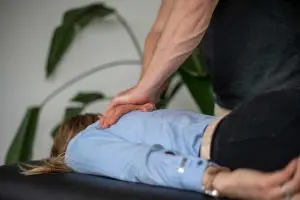
Our chiropractors and physical therapy staff will assess each person for not only the symptoms that come along with any injury, but the person as a whole. They will get to the root of the problem and will develop a care plan to help treat the cause of the underlying issue and the symptoms that come with it.
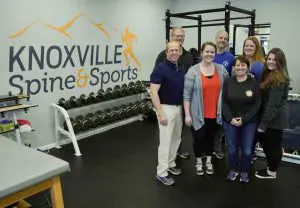
The treatment plan will involve spinal manipulation (chiropractic adjustment), manual therapies, and therapeutic exercises or stretches tailored to your typical level of activity, overall health, and current pain level:
Chiropractors don’t “pop” your disc back into place—that is a misconception. They also don’t use forceful adjustments to manhandle your disc back in place. If you hear a popping sound, that is essentially the gas release from a joint—that’s all! Chiropractic care involves gentle low-force techniques that over time restore your spine and discs to their proper positions.
Many patients find great relief from chiropractic care for their herniated discs. Just know that in some cases, your chiropractor may refer you to a spine surgeon. Sometimes, the initial exam reveals extensive disc damage that can only be repaired by surgery. Sometimes, symptoms don’t improve with chiropractic care. In both these cases, your chiropractor may recommend a pain specialist, a spine surgeon, or both. Often, chiropractors are part of a team of professionals that co-manage or group to manage your herniated disc issues.
If you are suffering from symptoms related to a bulging or herniated disc, call us today to set up your first appointment! (865) 337-5574
430 Montbrook Lane Suite 203
Knoxville, TN
37919
Phone: 865-337-5574
Monday
7am-12pm & 1pm-6pm
Tuesday
7am-12pm & 1pm-4pm
Wednesday
7am-1pm
Thursday
7am-12pm & 1pm-6pm
Friday
7am-12pm & 1pm-4pm
Saturday & Sunday
Closed